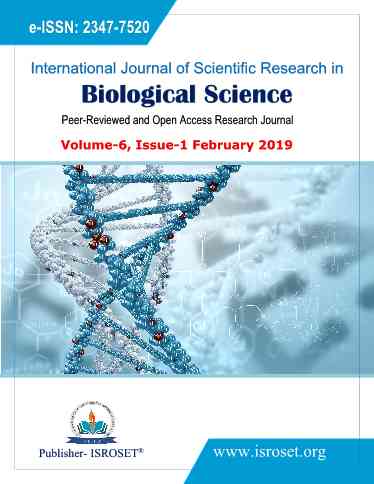Synthesis and characterization of Cadmium (II) complex with tetradentate N2O2- donor Schiff base and biological activity
Keywords:
Cadmium complex, Bovine serum albumin interaction, antibacterial activityAbstract
Transition metal complex of Cd (II) with tetradentate schiff base derived from the condensation of 4-nitro-1,2-diamino benzene and 5-nitro-salicyldehyde (H2L) have been synthesized. The synthesized square planar complex was investigated using elemental analysis (C, H and N), infrared, conductivity and electronic spectroscopic tools. The interactions of cadmium (II) complex examined towards Bovine serum albumin (BSA) with the help of absorption and fluorescence spectroscopic tools. The complex is strongly binds to proteins, then we study the antibacterial activity of the Schiff base and its cadmium complex by agar disc diffusion method against some species of pathogenic bacteria (Escherichia coli, Vibrio cholerae, Streptococcus pneumonia and Bacillus cereus).The result indicated that cadmium complex was more activity than ligand due to higher lipophilicity effect.
References
Chakraborty, A., Kumar, P., Ghosh, K., Roy, P., Evaluation of a Schiff base copper complex compound as potent anticancer molecule with multiple targets of action, 2010. Eur J Pharmacol, 647, 1-12.
Keypour, H., Shayesteh, M., Rezaeivala, M., Chalabian, F., Elerman, Y., Buyukgungor, O., Synthesis, spectral characterization, structural investigation and antimicrobial studies of mononuclear Cu(II), Ni(II), Co(II), Zn(II) and Cd(II) complexes of a new potentially hexadentate N2O4 Schiff base ligand derived from salicylaldehyde. 2013. J.Mol. Structure, 1032, 62–68.
Konar, S., Jana, A., Das, K., Ray, S., Chatterjee, S., Golen, J.A., Rheingold, A.L., Kar, S.K., Synthesis, crystal structure, spectroscopic and photoluminescence studies of manganese(II), cobalt(II), cadmium(II), zinc(II) and copper(II) complexes with a pyrazole derived Schiff base ligand. 2011. Polyhedron, 30, 2801-2808.
Cordes, E.H., Jencks, W.P., On the Mechanism of Schiff Base Formation and Hydrolysis. 1962. J. Am. Chem. Soc, 84, 832-837.
Asadi, M., Sadi, S.B., Asadi, Z., Yousefi, R., Sadi, A.R.B., Hezarjaribi, H.K., Synthesis, characterization, and thermodynamic studies of the interaction of some new water-soluble Schiff-base complexes with bovine serum albumin. 2012. J. Coord. Chem. 65, 722–739.
Carter, D.C., Ho, J.X., Structure of Serum Albumin. 1994. Adv. Protein Chem. 45, 153-203.
Mann, C.M., Markham, J.L., 1998. A new method for determining the minimum inhibitory concentration of essential oils. J. Appl. Microbiol, 84, 538-544.
Baba1, D. R., Junaid, P. M., Khan, F., Singh, R., Nitric Oxide Scavenging Activity of Bioactive Compounds Present in Methanolic Extract of Morchella esculenta. 2018. International Journal of Scientific Research in Biological Sciences. 5, 39-41.
Hazra, M., Dolai, T., Giri, S., Patra, A., Dey, S.K., 2014. Synthesis of biologically active cadmium (II) complex with tridentate N2O donor Schiff base: DFT study, binding mechanism of serum albumins (bovine, human) and fluorescent nanowires, J. Saudi Chem. Soc. 21, S445-S456.
Gelamo, E.L., Tabak, M., 2000. Spectroscopic studies on the interaction of bovine (BSA) and human (HSA) serum albumins with ionic surfactants. Spectrochim. Acta,Part A, 56, 2255-2271.
Benesi, H.A., Hildebrand, J.H., 1949. A spectrophotometric investigation of the interaction of iodine with aromatic hydrocarbons. J. Am. Chem. Soc. 71, 2703-2707.
Zhang, X.P., Hou, Y.H., Wang, L., Zhang, Y.Z., Liu, Y., 2013. Exploring the mechanism of interaction between sulindac and human serum albumin: Spectroscopic and molecular modeling methods. J. Lumin, 138, 8-14.
Stern, O.and M. Volmer, 1919. “über die Abklingzeit der Fluoreszenz,” Zeitschrift für Physik, 20, 183-188.
Gaballa, A.S., Teleb, S.M., Asker, M.S., Yalçin, E., Seferoğlu, Z., 2011. Synthesis, spectroscopic properties, and antimicrobial activity of some new 5-phenylazo-6-aminouracil-vanadyl complexes, J. Coord. Chem. 64, 4225–4243.
Pandeya, S.N., Sriram, D., Nath, G., De Clercq, E., 1999. Synthesis, antibacterial, antifungal and antiviral activity evaluation of some new bis-Schiff bases of isatin and their derivatives. Pharm. Acta Helv. 74, 11-17.
Downloads
Published
How to Cite
Issue
Section
License

This work is licensed under a Creative Commons Attribution 4.0 International License.
Authors contributing to this journal agree to publish their articles under the Creative Commons Attribution 4.0 International License, allowing third parties to share their work (copy, distribute, transmit) and to adapt it, under the condition that the authors are given credit and that in the event of reuse or distribution, the terms of this license are made clear.







